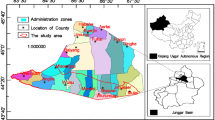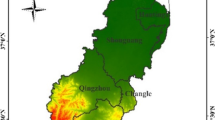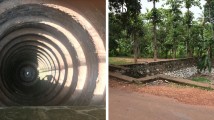Abstract
In arid and semi-arid regions, a close relationship exists between groundwater and supergene eco-environmental issues such as swampiness, soil salinization, desertification, vegetation degradation, reduction of stream base flow, and disappearance of lakes and wetlands. When the maximum allowable withdrawal of groundwater (AWG) is assessed, an ecology-oriented regional groundwater resource assessment (RGRA) method should be used. In this study, a hierarchical assessment index system of the supergene eco-environment was established based on field survey data and analysis of the supergene eco-environment factors influenced by groundwater in the Tuwei River watershed, Shaanxi Province, China. The assessment system comprised 11 indices, including geomorphological type, lithology and structure of the vadose zone, depth of the water table (DWT), total dissolved solids content of groundwater, etc. Weights for all indices were calculated using an analytical hierarchy process. Then, the current eco-environmental conditions were assessed using fuzzy comprehensive evaluation (FCE). Under the imposed constraints, and using both the assessment results on the current eco-environment situation and the ecological constraint of DWT (1.5–5.0 m), the maximum AWG (0.408 × 108 m3/a or 24.29 % of the river base flow) was determined. This was achieved by combining the groundwater resource assessment with the supergene eco-environmental assessment based on FCE. If the maximum AWG is exceeded in a watershed, the eco-environment will gradually deteriorate and produce negative environmental effects. The ecology-oriented maximum AWG can be determined by the ecology-oriented RGRA method, and thus sustainable groundwater use in similar watersheds in other arid and semi-arid regions can be achieved.
Résumé
Dans les régions arides et semi-arides, une relation étroite existe entre l’eau souterraine et les phénomènes éco-environnementaux supergènes, tels que l’inondation, la salinisation du sol, la désertification, la dégradation de la végétation, la réduction de l’écoulement de base du cours d’eau et la disparition des lacs et des zones humides. Quand le prélèvement maximum admissible en eau souterraine (PMAES) est défini, une méthode d’évaluation de la ressource régionale en eau souterraine (ERRES) axée sur l’écologie peut être utilisée. Dans la présente étude, un système d’index d’évaluation hiérarchisé de l’éco-environnement de surface a été établi sur la base des données relevées sur le terrain et de l’analyse des facteurs éco-environnementaux de surface influencés par l’eau souterraine dans le bassin versant de la Rivière Tuweï, Province du Shaanxi, Chine. Le système d’évaluation comprenait 11 indices, incluant le type géomorphologique, la lithologie et la structure de la zone non saturée, la profondeur de la surface piézométrique (PSP), la teneur en matières dissoutes totales de l’eau souterraine, etc. Le poids de chaque indice a été calculé par une méthode d’analyse hiérarchisée. Ensuite, les conditions éco-environnementales actuelles ont été établies en utilisant une évaluation globale de logique floue (EGF). Sous les contraintes imposées, et en utilisant à la fois les résultats de l’évaluation de la situation éco-environnementale actuelle et les contraintes écologiques liées à la profondeur de la surface piézométrique PSP (1.5–5.0 m), le prélèvement maximum admissible en eau souterraine PMAES (0.408 × 108 m3/a ou 24.29 % de l’écoulement de base de la rivière) a été déterminé. Ceci a été mené à bien en combinant l’évaluation de la ressource en eau souterraine et l’évaluation éco-environnementale de la surface sur la base de l’EGF. Si le prélèvement maximum admissible en eau souterraine (PMAES) est dépassé dans un bassin versant, l’éco-environnement se détériorera graduellement et provoquera des effets environnementaux négatifs. Le prélèvement maximum admissible en eau souterraine (PMAES) peut en égard à l’écologie être déterminé par la méthode de l’évaluation de la ressource régionale en eau souterraine (ERRES) axée sur l’écologie, et une utilisation durable de l’eau souterraine de bassins similaires dans d’autres régions arides ou semi-arides peut ainsi être réalisée.
Resumen
En las regiones áridas y semiáridas, existe una estrecha relación entre el agua subterránea y los problemas eco-ambientales supergénicos, tales como la generación de pantanos, la salinización del suelo, la desertificación, la degradación de la vegetación, la reducción del flujo de base y la desaparición de lagos y humedales. Cuando se evalúa la máxima extracción permisible del agua subterránea (AWG) se debe utilizar un método de evaluación regional de los recursos de agua subterránea orientada a la ecología (RGRA). En este estudio, se estableció un sistema de índices de evaluación jerárquica del ambiente ecológico supergénico basado en datos de encuestas de campo y análisis de los factores supergénicos de un ambiente ecológico influenciado por el agua subterránea en la cuenca del río Tuwei, provincia de Shaanxi, China. El sistema de evaluación compuesto por 11 índices, incluye el tipo geomorfológico, litología y la estructura de la zona no saturada, la profundidad de la capa freática (DWT), el contenido total de sólidos disueltos de las aguas subterráneas, etc. Se calcularon los pesos de los índices utilizando un proceso de jerarquía analítica. Luego, las condiciones eco-ambientales actuales se evaluaron utilizando la evaluación integral difusa (FCE). En virtud de las restricciones impuestas, y utilizando los resultados de la evaluación de la situación eco-ambiental actual y las limitaciones ecológicas de la DWT (1.5–5.0 m) se determina la máxima AWG (0.408 × 108 m 3/a ó un 24.29 % del caudal base de los ríos). Esto se logró mediante la combinación de la evaluación de los recursos de agua subterránea con la evaluación ecológica del medio ambiente supergénico basado en la FCE. Si el máximo AWG supera un punto de inflexión, el ambiente ecológico se deteriorará gradualmente y producirá efectos ambientales negativos. El máximo AWG orientado a la ecología se puede determinar por el método RGRA orientado a la ecología, y así se puede lograr el uso sostenible del agua subterránea en cuencas similares en otras regiones áridas y semiáridas.
摘要
在干旱半干旱地区,地下水与沼泽化、盐渍化、沙漠化、植被退化、河流基流量衰减、湖泊与湿地消亡等表生生态环境问题之间关系密切。在评价地下水最大可采量时,应采用面向生态的区域地下水资源评价方法。本研究基于中国陕北秃尾河流域野外调查数据和受地下水影响的表生生态环境问题的因素分析,建立了地下水引发的表生生态环境问题的递阶评价指标体系。该评价指标体系由地貌类型、包气带岩性和结构、地下水位埋深及地下水总溶解性固体含量等11个指标构成。指标的权重采用层次分析法计算。采用模糊综合评判法对生态环境现状进行了评价。在生态环境现状评价结果和生态地下水位埋深(1.5–5.0 m)两个约束条件下,将地下水资源评价与基于模糊综合评判的表生生态环境评价耦合起来,确定了流域地下水最大可采量为0.408 × 108 m3/a,占到河流基流量的24.29 %。若一个流域地下水开采量超过了其地下水最大可采量,其生态环境将渐趋恶化,并产生生态环境负效应。面向生态的地下水最大可采量可通过面向生态的区域地下水资源评价方法来确定,从而实现其他干旱半干旱地区类似流域地下水资源可持续利用。
Resumo
Em regiões áridas e semiáridas, existe uma relação próxima entre problemas com águas subterrâneas e com processos supergênicos eco-ambientais, tais como pântanosidade, salinização do solo, desertificação, degradação da vegetação, redução da vazão de base do rio, e desaparecimento de lagos e pântanos. Ao avaliar-se a máxima vazão outorgável de água subterrânea (VOAS), deve-se adotar um método para avaliação dos recursos hídricos subterrâneos regional (ARHS) orientado à ecologia. Neste trabalho, foi estabelecido um sistema com índice de avaliação hierárquica do processo supergênico eco-ambiental baseado dados de pesquisa de campo e análise de fatores supergênicos eco-ambientais influenciados pelas águas subterrâneas na bacia do Rio Tuwei, Província de Shaanxi, China. O sistema de avaliação consiste em 11 índices, incluindo tipo geomorfológico, litologia e estrutura da zona vadosa, profundidade do nível freático (PNF), conteúdo de sólidos dissolvidos na água subterrânea, etc. Utilizou-se um processo analítico hierárquico para calcular pesos para todos os índices. Em seguida, as condições eco-ambientais atuais foram avaliadas por meio de avaliação fuzzy compreensiva (AFC). Sob as restrições impostas, e usando ambos os resultados de avaliação na situação eco-ambiental atual e de restrição ecológica de PNF (1.5–5.0 m), determinou-se a máxima VOAS (0.408 × 108 m3/a ou 24.29 % da vazão de base do rio). Isto foi alcançado por meio da combinação da avaliação de recursos hídricos subterrâneos com a avaliação dos processos supergênicos eco-ambientais baseado na AFC. Se a máxima VOAS for excedida na bacia, o eco-ambiente irá deteriorar-se gradualmente e produzir efeitos ambientais negativos. A máxima VOAS orientada à ecologia pode ser determinada pelo método ARHS com orientação à ecologia, e o uso sustentável da água subterrânea em bacias similares em regiões áridas e semiáridas pode ser alcançado.







Similar content being viewed by others
References
Alley WM, Leake SA (2004) The journey from safe yield to sustainability. Ground Water 42(1):12–16
Alley WM, Reilly TE, Franke OL (1999) Sustainability of ground-water resources. US Geol Surv Circ 1186:1–79
Barlow JR, Coupe RH (2012) Groundwater and surface-water exchange and resulting nitrate dynamics in the Bogue Phalia Basin in northwestern Mississippi. J Environ Qual 41(1):155–169. doi:10.2134/jeq2011.0087
Barthel R, Jagelke J, Gotzinger J, Gaiser T, Andreas P (2008) Aspects of choosing appropriate concepts for modelling groundwater resources in regional integrated water resources management: examples from the Neckar (Germany) and Oueme catchment (Benin). Phys Chem Earth 33:92–114
Fan ZL (1996) Ecological environment Influence and its countermeasures of land development in Xinjiang. Meteorology Press, Beijing, 174, pp
Griebler C, Stein H, Kellermann C, Berkhoff S, Brielmann H, Schmidt S, Selesi D, Steube C, Fuchs A, Hahn HJ (2010) Ecological assessment of groundwater ecosystems: vision or illusion? Ecol Eng 36(9):1174–1190
Hattermann F, Krysanova V, Wechsung F, Wattenbach M (2004) Integrating groundwater dynamics in regional hydrological modelling. Environ Model Softw 19(11):1039–1051
Hillel D (2004) Introduction to environmental soil physics. Elsevier, Amsterdam, 14 pp
Kalf FRP, Woolley DR (2005) Applicability and methodology of determining sustainable yield in groundwater systems. Hydrogeol J 13(13):295–312
Luo JX, Liu ZY, Gao YR, Wei YQ, Fan DY, Tian ZX (1985) Improvement of saline and alkali land of reclamation areas in Xinjiang Uygur Autonomous Region of P.R. China. Hydraulic and Electric Power Press of Peking, Beijing, 36 pp
Maimone M (2004) Defining and managing sustainable yield. Ground Water 42(6–7):809–814
Menció A, Mas-Pla J (2010) Influence of groundwater exploitation on the ecological status of streams in a Mediterranean system (Selva Basin, NE Spain). Ecol Indic 10(5):915–926
Nakayama T (2013) For improvement in understanding eco-hydrological processes in mire. Ecohydrol Hydrobiol 13(1):62–72.doi:10.1016/j.ecohyd.2013.03.004
Qian YP, Jiang XH, Jin SY, Zhang PD (2004) Analysis on the characteristic and variation of base flow in the loessial plateau of the middle reaches of Huanghe River (in Chinese). J Earth Sci Environ 26(2):88–91
Scanlon BR, Healy RW, Cook PG (2002) Choosing appropriate techniques for quantifying groundwater recharge. Hydrogeol J 10(1):18–39
Shi FZ, Chi BM, Zhao CY, Yang T, Paix MJDL, Lu Y, Gao SQ (2012) Identifying the sustainable groundwater yield in a Chinese semi-humid basin. J Hydrol 452–453:14–24
Sophocleous M (2000) From safe yield to sustainable development of water resources: the Kansas experience. J Hydrol 235(s 1–2):27–43
Wang WK, Yang ZY, Cheng DH, Wang WM, Yang HB (2011) Methods of ecology-oriented groundwater resource assessment in arid and semi-arid areas (in Chinese) . J Jilin Univ (Earth Science Edition) 41(1):159–167
Wattenbach M, Hattermann F, Weng R, Wechsung F, Krysanova V, Badeck F (2005) A simplified approach to implement forest eco-hydrological properties in regional hydrological modeling. Ecol Model 187(1):40–59
Yang T, Hao XB, Shao QX, Xu CY, Zhao CY, Chen X, Wang WG (2012) Multi-model ensemble projections in temperature and precipitation extremes of the Tibetan Plateau in the 21st century. Global Planet Chang 80–81:1–13
Yang ZY (2004) Study on supergene ecological effect excited by groundwater and its assessment: a case study in the Tuwei River drainage. PhD Thesis, Chang′an University, China
Yang ZY, Wang WK (2009) Reviews and prospects on eco-effect induce by groundwater in arid and semiarid regions (in Chinese). Arid Land Geogr 32(5):739–745
Yang ZY, Wang WK, Huang JT, Duan L (2006) Buried depth of eco-safety about water table in the blown-sand region of the Northern Shaanxi Province (in Chinese). J Northwest Sci Tech Univ Agri (Natural Science edn.) 34(8):67–74
Zhang GX, Deng W, He Y (2002) The simulation and optimized management model of groundwater systems based on eco-environmental water demand (in Chinese). Acta Geogr Sinica 57(5):611–618
Zondy Cyber (2014) Website (in Chinese). http://www.mapgis.com.cn/. Accessed December 2014
Zuo QT, Chen X, Yang L (2001) Quantitative study on eco-environmental control of arid land, western China (in Chinese). Arid Land Geogr 24(2):146–151
Acknowledgements
This study was supported by grants from the National Natural Science Foundation of China (41272247, 41230314, 41272246), the Scientific Research Foundation for the Returned Overseas Chinese Scholars, the State Education Ministry (2013C0290418), the Open Research Fund of Key Laboratory of Subsurface Hydrology and Ecological Effect in Arid Regions of the Ministry of Education (2013G1502031), and from the Special Fund for Basic Scientific Research of Central Colleges, Chang′an University (2014G2290018). We thank Dr. Erwin Oh, Dr. R.F. Diffendal, and Dr. Y.Q. Zhao for improving the manuscript with their suggestions. We would like to thank Enago (www.enago.com) for the preliminary English language review.
Author information
Authors and Affiliations
Corresponding author
Appendix
Appendix
- AHP:
-
Analytical hierarchy process
- AWG:
-
Allowable withdrawal of groundwater
- BFI:
-
Base flow index
- DWT:
-
Depth of the water table
- EAM:
-
Eco-environmental assessment model
- EEAIS:
-
Ecological environment assessment information system
- FCE:
-
Fuzzy comprehensive evaluation
- GAM:
-
Groundwater assessment models
- NICE:
-
Process-based national integrated catchment-based ecohydrology
- RGRA:
-
Regional groundwater resource assessment
- SEEIGW:
-
Supergene eco-environmental effects induced by groundwater withdrawal
- WFCWS:
-
Well field for concentrated water supply
- WFDWS:
-
Well field for deconcentrated water supply
Rights and permissions
About this article
Cite this article
Yang, Z.Y., Wang, W., Wang, Z. et al. Ecology-oriented groundwater resource assessment in the Tuwei River watershed, Shaanxi Province, China. Hydrogeol J 24, 1939–1952 (2016). https://doi.org/10.1007/s10040-016-1446-3
Received:
Accepted:
Published:
Issue Date:
DOI: https://doi.org/10.1007/s10040-016-1446-3




